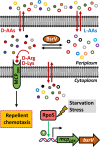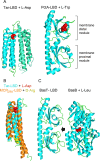Bacterial amino acid chemotaxis: a widespread strategy with multiple physiological and ecological roles
- PMID: 39330213
- PMCID: PMC11500578
- DOI: 10.1128/jb.00300-24
Bacterial amino acid chemotaxis: a widespread strategy with multiple physiological and ecological roles
Abstract
Chemotaxis is the directed, flagellum-based movement of bacteria in chemoeffector gradients. Bacteria respond chemotactically to a wide range of chemoeffectors, including amino, organic, and fatty acids, sugars, polyamines, quaternary amines, purines, pyrimidines, aromatic hydrocarbons, oxygen, inorganic ions, or polysaccharides. Most frequent are chemotactic responses to amino acids (AAs), which were observed in numerous bacteria regardless of their phylogeny and lifestyle. Mostly chemoattraction responses are observed, although a number of bacteria are repelled from certain AAs. Chemoattraction is associated with the important metabolic value of AAs as growth substrates or building blocks of proteins. However, additional studies revealed that AAs are also sensed as environmental cues. Many chemoreceptors are specific for AAs, and signaling is typically initiated by direct ligand binding to their four-helix bundle or dCache ligand-binding domains. Frequently, bacteria possess multiple AA-responsive chemoreceptors that at times possess complementary AA ligand spectra. The identification of sequence motifs in the binding sites at dCache_1 domains has permitted to define an AA-specific family of dCache_1AA chemoreceptors. In addition, AAs are among the ligands recognized by broad ligand range chemoreceptors, and evidence was obtained for chemoreceptor activation by the binding of AA-loaded solute-binding proteins. The biological significance of AA chemotaxis is very ample including in biofilm formation, root and seed colonization by beneficial bacteria, plant entry of phytopathogens, colonization of the intestine, or different virulence-related features in human/animal pathogens. This review provides insights that may be helpful for the study of AA chemotaxis in other uncharacterized bacteria.
Keywords: amino acid; chemotaxis; signal transduction.
Conflict of interest statement
The authors declare no conflict of interest.
Figures





Similar articles
-
The dCache Domain of the Chemoreceptor Tlp1 in Campylobacter jejuni Binds and Triggers Chemotaxis toward Formate.mBio. 2023 Jun 27;14(3):e0356422. doi: 10.1128/mbio.03564-22. Epub 2023 Apr 13. mBio. 2023. PMID: 37052512 Free PMC article.
-
How Bacterial Chemoreceptors Evolve Novel Ligand Specificities.mBio. 2020 Jan 21;11(1):e03066-19. doi: 10.1128/mBio.03066-19. mBio. 2020. PMID: 31964737 Free PMC article.
-
Signal binding at both modules of its dCache domain enables the McpA chemoreceptor of Bacillus velezensis to sense different ligands.Proc Natl Acad Sci U S A. 2022 Jul 19;119(29):e2201747119. doi: 10.1073/pnas.2201747119. Epub 2022 Jul 13. Proc Natl Acad Sci U S A. 2022. PMID: 35858353 Free PMC article.
-
The use of isothermal titration calorimetry to unravel chemotactic signalling mechanisms.Environ Microbiol. 2020 Aug;22(8):3005-3019. doi: 10.1111/1462-2920.15035. Epub 2020 Jun 1. Environ Microbiol. 2020. PMID: 32329116 Review.
-
Chemotaxis of Beneficial Rhizobacteria to Root Exudates: The First Step towards Root-Microbe Rhizosphere Interactions.Int J Mol Sci. 2021 Jun 22;22(13):6655. doi: 10.3390/ijms22136655. Int J Mol Sci. 2021. PMID: 34206311 Free PMC article. Review.
Cited by
-
Structural and functional diversity of sensor domains in bacterial transmembrane receptors.Trends Microbiol. 2025 Jul;33(7):796-809. doi: 10.1016/j.tim.2025.02.019. Epub 2025 Mar 21. Trends Microbiol. 2025. PMID: 40121131 Review.
-
Thermal shift assay to identify ligands for bacterial sensor proteins.FEMS Microbiol Rev. 2025 Jan 14;49:fuaf033. doi: 10.1093/femsre/fuaf033. FEMS Microbiol Rev. 2025. PMID: 40720780 Free PMC article.
References
Publication types
MeSH terms
Substances
Grants and funding
LinkOut - more resources
Full Text Sources

